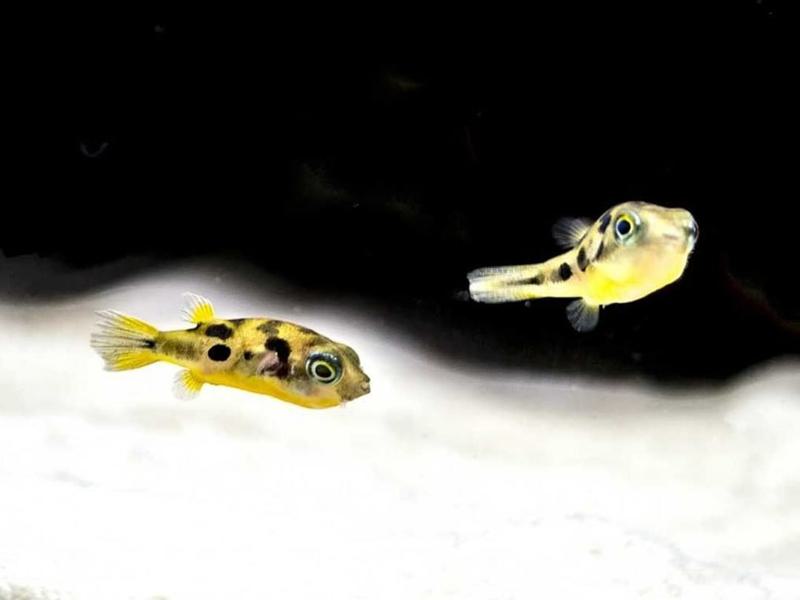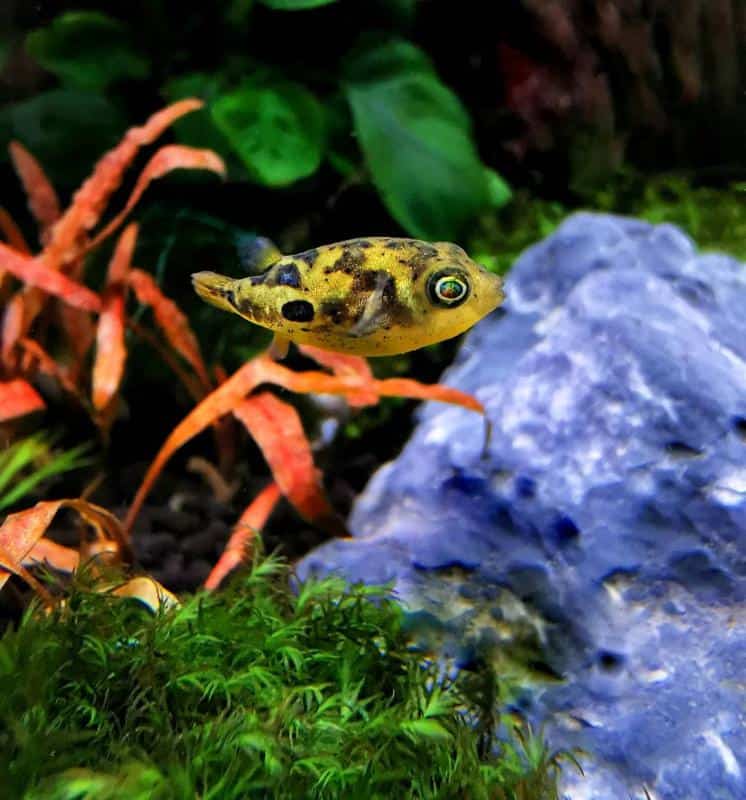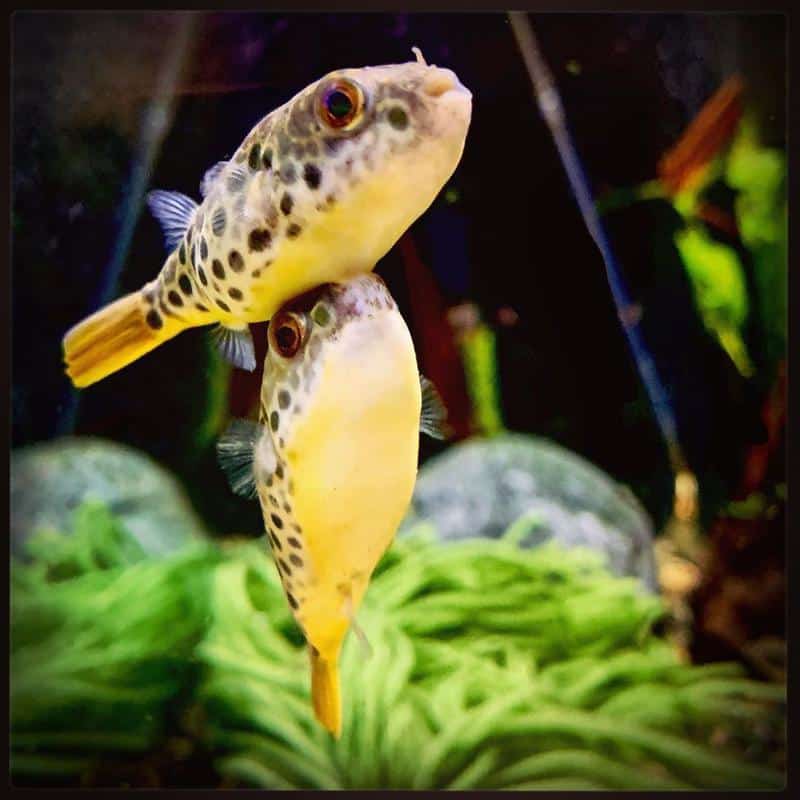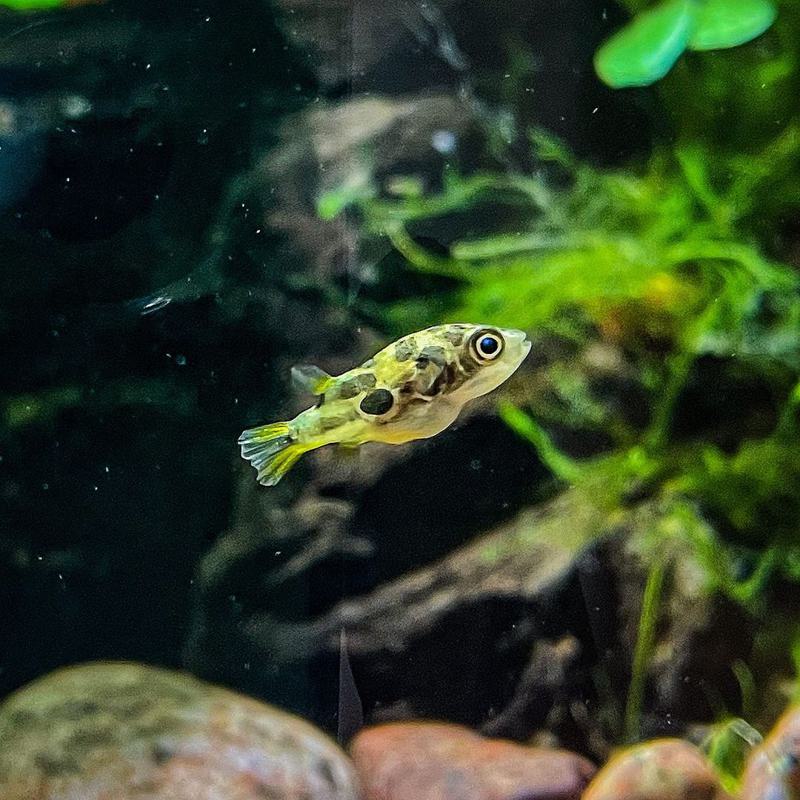The pea puffer is a charming little fish that packs a lot of personality despite its tiny size. Their inquisitive nature, alongside their intelligence and appetite for pest snails makes them a wonderful species to own, both for beginner and veteran aquarists.
If you’re thinking of adding a pea puffer to your aquarium or simply want to learn a bit more about their care, our guide will cover everything you need to know, including diet, tank mates, and setup.
Pea Puffer Overview

| Scientific name | Carinotetraodon travancoricus |
| Origin | Western Ghats of India |
| Habitat | Slow-moving, shallow waters with thick vegetation |
| Size | 1 inch |
| Temperament | Aggressive |
| Diet | Carnivore |
| Lifespan | 4-5 years |
| Tank size | 5 gallons |
| Water parameters | 6.5-8.5 pH, 4-10 dH, 74°-82°F |
| Care level | Easy |
Pea Puffer Origins & Habitat
The pea puffer, also commonly known as the dwarf pufferfish and pygmy pufferfish, is native to the rivers, lakes, and estuaries in the Western Ghats of India. They are popular among aquarists due to their small size, striking appearance, and intelligence.
Pea puffers inhabit shallow and slow-moving waters covered in floating plants and dense vegetation. They live in large shoals for both social and security purposes.
Interestingly, unlike many other species of pufferfish that can live in saltwater or brackish waters, pea puffers are entirely freshwater fish.
What Do Pea Pufferfish Look Like?
The pea puffer is an incredibly beautiful fish. They have a small, rounded body that is a deep golden-yellow color. Along their backs are iridescent patches that range from dark green to brown-black.
How to Sex Pea Pufferfish
Male and female pea puffers look almost identical, so it can be quite difficult to tell them apart, especially as juveniles. That being said, males are usually more vibrant in color than females with darker patches and brighter yellow bellies.
In addition, male pea puffers are normally slimmer and often have a bold line that goes across their body. They can also have wrinkles under their eyes that are blue in color.
How Big Do Pea Puffers Get?
The pea puffer is the smallest species of pufferfish, reaching just 1 inch in length. Females are usually larger and rounder than males.
How Long Do Pea Puffers Live For?
Pea puffers typically live for 4 to 5 years. Good water quality, the right tank size and setup, and a varied diet can all help contribute to a longer life expectancy,
Behavior
At first glance, pea puffers look rather cute and friendly, but their temperament is the complete opposite. They are extremely aggressive, especially males, which is why it’s best to house them alone or in groups with at least 2 females to every male.
If kept in shoals, it’s not uncommon for pea puffers to circle around other members of the group, usually with their tails curved slightly. This is completely normal and is simply a sign of defense. Some specimens display the same behavior when investigating an unfamiliar object in their tank.
Aside from their hostile nature, pea puffers are highly inquisitive and intelligent. They enjoy exploring their environment and are quick to learn feeding and aquarium maintenance routines.
Pea puffers, like betta fish, have been known to jump outside their aquarium, so it’s worth using a hood or tight-fitting cover on your tank to prevent any accidents.
Solitary pea pufferfish can be quite timid compared to those kept in groups, but they should eventually come out of their shell once they’ve grown accustomed to their new surroundings.
Pea Puffer Care
Pea pufferfish care is pretty straightforward, making the species a great choice for new aquarists. These fish are relatively hardy, tolerant to a wide range of water parameters, and can be housed in nano tanks.
However, pea puffers can be picky eaters as they have a strong preference for live foods. Some specimens may not accept pellets or flakes at first, so the transition to freeze-dried foods can take a while.
What Size Tank Do Pea Puffers Need?
The minimum tank size for a pea puffer is 5 gallons. Despite their compact size, pea puffers are lively and active fish, so we wouldn’t recommend less than 5 gallons for a single specimen.
Bear in mind that if you want to own multiple pea puffers, you’ll need a larger tank to spread out aggression and prevent territoriality disputes.
How Many Pea Puffers Should I Keep?
In aquariums less than 20 gallons in volume, it’s best to keep just a single pea puffer as they can be very territorial. In aquariums over this size, you can keep more than 6, but avoid keeping more than one male together unless you have a big tank.
In addition, we personally wouldn’t advise keeping less than 6 of these fish, even though technically you could house up to 3 in a 10-gallon aquarium. This is because aggression is often heightened in smaller groups, more so in undersized aquariums.
How Many Pea Puffers In a 20-Gallon Tank?
Up to 6 pea puffers can live in a 20-gallon tank, though your chances of success greatly depend on the personality of your fish and your overall setup. It’s best to allow around 2-3 gallons of space for each fish to minimize aggression.
What Do Pea Puffers Like In Their Tank?

As pea puffers originate from slow-moving waters with lots of plants, you should make sure your aquarium has plenty of vegetation to help them feel safe and secure.
Floating plants like duckweed, water lettuce, and frogbit are particularly great options. Thick, bushy plants like java fern, java moss, and anubias will also help your fish more at home and provide them with hiding places.
Adding vegetation to your tank is useful if you plan on owning multiple pea puffers as it will break up sight lines to assist with territory disputes.
Substrate
Any substrate will do the trick in a pea puffer aquarium, though you may want to opt for nutrient-rich aqua soil and gravel to facilitate plant growth.
Filter
Pea puffers live in slow-moving waters and aren’t fast swimmers, so a simple filter with a low current is preferable, such as a sponge filter or HOB (hang-on-back) filtration system.
In addition, as smaller tanks can only accommodate a single pea puffer, you won’t need an overly powerful filter as there will be very little waste generated.
Lighting
There’s no specific aquarium light you need for a pea puffer setup. A basic fluorescent or LED lighting system will work to keep your tank illuminated and provide your fish with a natural day and night cycle.
That being said, if you have a lot of plants in your aquarium, it might be worth investing in an aquarium light targeted for planted setups to assist with plant growth and color.
Pea Puffer Tank Mates

Unfortunately, pea puffers don’t make ideal candidates for community tanks due to their aggressive nature, so your stocking choices are limited.
Pea pufferfish also have a large appetite for snails and shrimp, which means even invertebrates are off-limits.
The best tank mates for a pea pufferfish setup are other pea puffers, but as mentioned earlier, you’ll need at least a 20-gallon fish tank to accommodate a small group.
If you’re set on keeping your pea puffer with other fish, make sure you have a large enough tank to help prevent any conflicts in territory.
Bottom dwellers like kuhli loaches, otocinclus, and corydoras catfish can make decent roommates as they won’t interfere with your pea puffer’s territory. Small, fast-moving fish like danios and neons can also sometimes work as they will be too quick for your pea puffer to chase.
However, no fish is truly safe with a pea puffer as they are notorious fin nippers. Some specimens may be fine initially with other fish, but there’s no guarantee that they won’t eventually harm or even kill all inhabitants in your tank.
Ideal Pea Puffer Water Parameters
Although pea puffers are pretty hardy fish, they still need specific water parameters to be happy and healthy. Ideally, the pH in your tank should be between 6.5 to 8.5 and the general hardness should fall within 4 to 10 dH.
As pea puffers originate from tropical waters, you’ll need to make sure your aquarium is heated to approximately 74 to 82°F.
What Do Pea Pufferfish Eat?

The pea pufferfish is a carnivore through and through, so their primary diet should be protein-rich foods. They can be quite finicky eaters as they prefer live foods.
Live or frozen brine shrimp, bloodworms, black worms, pest snails (these are universally loved by the species), and small shrimp are good choices. Pellet and flake food can also be offered, but it can take some time for your pea puffer to accept them.
Do Pea Puffers Eat Snails?
Yes, pea puffers do eat snails. They’ll eat any type of aquatic snail, including pest ones like pond and bladder snails.
This makes the species an excellent option for aquarists battling a snail infestation as they’ll make quick work of the critters.
Also Read: Aquarium Fish that Eat Snails
How Often Do You Feed Pea Puffers?
You should feed your pea puffer twice a day: once in the morning and once in the evening. You should mix up their food regularly to add variety to their diet and ensure they receive a range of nutrients.
Make sure you don’t overfeed your pea puffer as it can lead to bloating and poor water quality.
Pea Puffer Breeding
Breeding pea puffers isn’t overly difficult as male/female shoals will naturally spawn if their tank conditions and diet are right. However, there are several things you can do to trigger the spawning process and raise healthy fry.
Step 1
It’s best to set up a separate breeding tank for a male/female pair as pea pufferfish can be territorial during mating, especially males. This will also prevent your other fish from eating the eggs.
Step 2
Raise the temperature of the breeding tank to 79°F and add plenty of moss (java moss or Christmas moss are good options) as female pea puffers prefer to lay their eggs on dense vegetation. You can also introduce other bushy plants to the aquarium.
Step 3
If the pair are interested in mating, the male will chase the female around the aquarium. Once she’s ready to lay her eggs, she will take the male to her chosen spawning location (normally a clump of moss).
Step 4
The female will scatter her eggs over the moss as the male fertilizes them. It’s best to remove the parents at this point as they may try to eat their eggs. If you’re not using a separate breeding tank, it’s not uncommon for the male to guard the eggs until they hatch.
Step 5
Pea puffer eggs normally hatch within 48 hours after being laid. The newly emerged fry will consume their yolk sacs for 2 to 3 days, so you don’t need to feed them at this point.
Once the fry has consumed all of their yolk sacs, you can offer them infusoria, baby brine shrimp, or commercial fry food.
Baby pea puffers are very tiny, so you should avoid adding them to your main tank for a few weeks until they’ve had time to develop.
Read More: Popular Freshwater Puffer Fish
FAQs
Can Pea Puffers Live With Angelfish?
No, pea puffers cannot live with angelfish. Pea pufferfish are fin nippers, so they’re likely to bite the long, delicate fins of angelfish.
Can Pea Puffers Live With Betta Fish?
Although similar in size and temperament to betta fish, housing pea puffers with betta fish usually doesn’t work. Pea puffers will nip and harass a betta fish due to their long fins. In addition, the aggressive personalities of both species will probably clash.
Are Pea Puffers Hard to Take Care Of?
Pea puffers are pretty undemanding when it comes to care, so they’re not hard to look after. The only challenge is their pickiness regarding food, but this shouldn’t be an issue if you feed them live prey.
Are Pea Puffers Aggressive?
Yes, pea pufferfish are aggressive, both towards their own species and other fish. Males in particular are highly territorial, so housing more than one in a small tank isn’t recommended.
Final Thoughts
The pea pufferfish is a fin-tastic species to own if you’re looking for a colorful, intelligent, playful fish to bring into your home. Despite being no bigger than an inch, pea puffers have a lot to offer.
They’re relatively low-maintenance (just make sure you feed them well and stay on top of water changes) and can even help you solve pest snail infestations.
Better yet, their inquisitiveness and ability to bond with their owners make them much more interactive than most other similarly-sized fish.